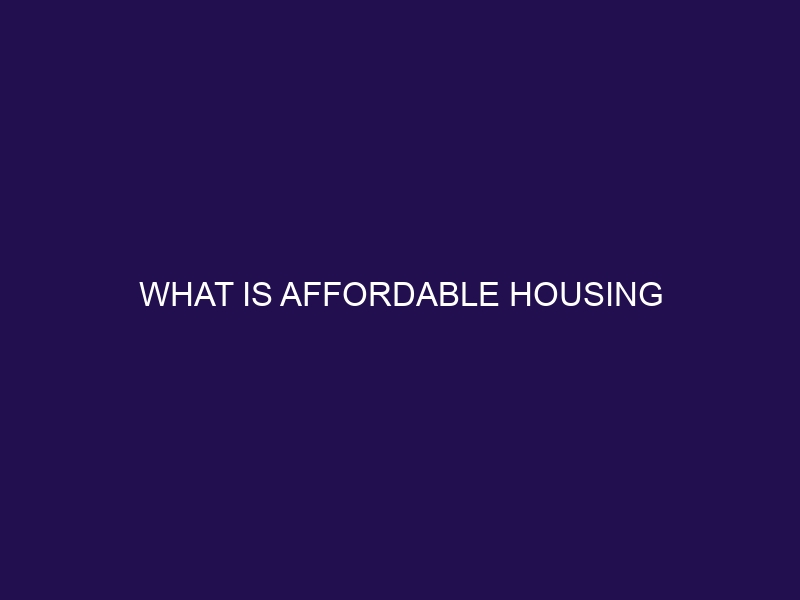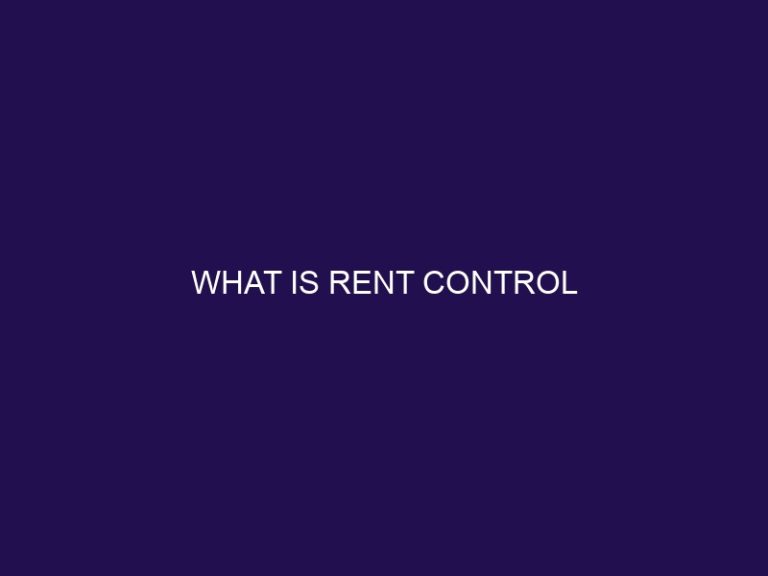What is Affordable housing
Affordable housing is a critical issue that affects individuals and communities worldwide. It plays a crucial role in addressing the housing needs of low and middle-income individuals and families. Affordable housing refers to housing units that are priced in a way that they are affordable to individuals or families with limited financial means. It aims to provide safe and decent housing options that do not burden households financially.
To better understand affordable housing, it is essential to define the concept and explore the criteria used to determine affordability. Affordable housing is defined as housing that costs no more than a specific percentage of a household’s income. The exact percentage may vary depending on factors such as location and household size. Criteria to determine affordability can include factors such as income levels, housing costs, and housing expenses in relation to income.
Affordable housing is of utmost importance for various reasons. Firstly, it has a significant socioeconomic impact by providing stability and security for individuals and families, which in turn positively affects their overall well-being. Secondly, affordable housing plays a vital role in community development by fostering inclusive neighborhoods and promoting diversity. It helps create vibrant communities where people from different backgrounds can live and thrive together.
However, achieving affordable housing poses several challenges. Many regions are facing a housing affordability crisis due to rising housing costs and stagnant wages. Various barriers such as limited land availability, lack of funding, and stringent regulations can hinder the creation of affordable housing.
To address this issue, governments implement initiatives to promote affordable housing. These initiatives can include subsidized housing programs, offering financial assistance to low-income households, and providing tax incentives and regulatory approaches to encourage affordable housing development.
Innovative solutions are also being explored to tackle the affordable housing crisis. Public-private partnerships bring together government entities and private developers to create affordable housing projects. Cooperative housing models involve residents collectively owning and managing the housing units, reducing costs. Alternative construction techniques, such as modular or prefabricated construction, can help streamline the building process and reduce expenses.
The benefits of affordable housing are far-reaching. It contributes to an improved quality of life for individuals and families by ensuring they have a safe and stable place to live. Affordable housing promotes social equality by providing access to housing for all, regardless of their financial status. It boosts economic growth by creating jobs in the construction industry and providing opportunities for local businesses.
What is Affordable Housing?
Discover the essence of affordable housing and unravel how its affordability is determined. Get ready to delve into the world of affordable housing and explore the criteria that play a crucial role in determining what truly makes a property affordable. Brace yourself for insights that will shed light on how the concept of affordable housing is much more than just a roof over one’s head. Stay tuned as we explore the intricacies of affordability in the housing market.
Criteria to Determine Affordability
Determining the affordability of housing involves considering various criteria to determine affordability that assess an individual or household’s financial capability to meet housing costs.
- Income: Evaluating the income level is crucial in determining affordability. Typically, a household should spend no more than 30% of their income on housing expenses.
- Housing Costs: Assessing the total housing costs, including rent or mortgage payments, property taxes, and insurance, helps determine if it aligns with the household’s income.
- Area Median Income: Comparing the household’s income to the area’s median income allows for a relative assessment of affordability. Affordable housing programs often set income limits based on the area median income.
- Housing Expenses Ratio: Calculating the housing expenses ratio by dividing housing costs by income provides an indicator of affordability. A lower ratio signifies higher affordability.
- Financial Obligations: Taking into account other financial obligations, such as debt payments and childcare costs, alongside housing costs, helps paint a comprehensive picture of affordability.
The Importance of Affordable Housing
Affordable housing plays a crucial role in society, and its importance cannot be overstated. In this section, we will explore the socioeconomic impact of affordable housing and how it contributes to community development. Brace yourself for eye-opening facts and figures that demonstrate the significant role affordable housing plays in addressing the housing needs of individuals and the positive ripple effects it creates in our communities. It’s time to unravel the importance of affordable housing and the immense benefits it brings to the table.
Socioeconomic Impact of Affordable Housing
- Affordable housing has a significant socioeconomic impact on individuals and communities.
- Improved Housing Stability: Access to affordable housing ensures that individuals and families have a stable place to live, reducing homelessness and housing insecurity.
- Enhanced Quality of Life: Affordable housing provides safe and decent living conditions, promoting better physical and mental health outcomes.
- Economic Benefits: Affordable housing stimulates local economies by creating jobs in construction and maintenance, as well as empowering residents to spend more on other goods and services.
- Reduced Inequality: Affordable housing helps address income inequality by providing low-income individuals and families with access to safe and affordable housing options.
- Community Development: Affordable housing fosters stronger communities by promoting social cohesion, supporting community networks, and instilling a sense of belonging.
The Role of Affordable Housing in Community Development
Affordable housing plays a crucial role in community development by addressing the housing needs of low-income individuals and families. It provides stable and affordable homes, which leads to numerous positive impacts. By reducing homelessness and providing a sense of security to residents, affordable housing promotes social equality and creates diverse and inclusive neighborhoods. Moreover, affordable housing contributes to economic growth by attracting businesses and creating job opportunities. Investing in affordable housing not only improves the lives of individuals and families, but also strengthens the overall fabric of the community. This, in turn, leads to a more prosperous and vibrant society.
Challenges in Achieving Affordable Housing
Low-cost housing continues to be an elusive goal, as we confront the hurdles hindering the realization of affordable housing. In this section, we’ll delve into the challenges posed by the housing affordability crisis and the barriers impeding the creation of affordable housing. Brace yourself to uncover the harsh realities, as we explore the factors that contribute to the difficulty of attaining affordable housing for individuals and families in need.
Housing Affordability Crisis
The housing affordability crisis is a pressing issue that affects many individuals and families around the world. The Housing Affordability Crisis is a significant problem due to rising housing costs and stagnant wages, as it affects a significant portion of the population struggling to find affordable housing options. This crisis has far-reaching consequences, from increased homelessness to decreased economic mobility. To address the Housing Affordability Crisis, governments and organizations need to prioritize affordable housing initiatives and implement policies that promote accessibility. Some potential solutions to tackle the Housing Affordability Crisis include offering subsidies and tax incentives to developers, promoting alternative construction techniques, and fostering public-private partnerships. By taking concerted action, we can mitigate the Housing Affordability Crisis and ensure that everyone has access to safe and affordable housing.
Barriers to Creating Affordable Housing
Barriers to Creating Affordable Housing
The implementation and availability of affordable housing face various obstacles that hamper their progress.
1. Land prices and availability: The escalating cost of land poses a challenge when searching for suitable locations for affordable housing projects. Additionally, limited availability in desirable areas further restricts the development of such housing.
2. High construction costs: The substantial expenses associated with construction, including materials, labor, and permits, present a significant barrier to creating affordable housing. Frequently, these costs surpass the available financing options.
3. Zoning and regulatory requirements: The presence of strict zoning laws and regulatory requirements can cause delays or even prevent the construction of affordable housing. These regulations can include restrictions on building height, mandatory parking spaces, or design standards that increase project costs.
4. NIMBYism (Not In My Backyard): Resistance from local communities and residents often emerges when plans for affordable housing projects are proposed. Concerns regarding property values, increased traffic, or changes to the neighborhood can generate opposition and prolong the process.
5. Lack of funding and subsidies: The limited availability of public funding and subsidies for affordable housing makes it challenging to finance projects. Without sufficient financial support, developers may encounter difficulties in ensuring the economic viability of their projects.
Addressing these barriers necessitates collaborative efforts among government entities, housing developers, and community stakeholders. These efforts should focus on policy reform, increasing funding opportunities, and raising public awareness about the benefits of affordable housing.
Government Initiatives to Promote Affordable Housing
Various government initiatives play a pivotal role in promoting affordable housing, addressing the pressing issue of housing affordability. By diving into the realm of subsidized housing programs, tax incentives, and regulatory approaches, we uncover the strategies deployed to make housing more accessible to all. Brace yourself for a deep dive into the world of affordable housing, where we explore the tools and measures employed by the government to tackle this crucial challenge head-on. Let’s explore these initiatives and how they shape the landscape of affordable housing.
Subsidized Housing Programs
Subsidized housing programs, such as the Section 8 Housing Choice Voucher Program, Public Housing, Low-Income Housing Tax Credit (LIHTC), and Project-Based Rental Assistance (PBRA), play a vital role in offering affordable housing options to low-income individuals and families. These programs aim to alleviate the burden of housing costs by providing rental assistance or reducing the overall cost of housing. Expanding and improving access to subsidized housing programs is crucial to address the housing affordability crisis and promote socioeconomic equality. It is essential to continue investing in and expanding these programs to ensure adequate and affordable housing for all. Additionally, implementing policies that encourage public-private partnerships and innovative construction techniques can lead to more efficient and sustainable affordable housing solutions.
Tax Incentives and Regulatory Approaches
The incorporation of tax incentives and regulatory approaches is crucial for governments to effectively promote affordable housing. By utilizing these tools, governments aim to establish a conducive environment for developers and investors, ensuring the financial viability of affordable housing options.
To illustrate the significance of tax incentives and regulatory approaches, consider the following table:
| Tax Incentives | Regulatory Approaches |
| Property tax exemptions | Zoning and land use regulations |
| Tax credits for affordable housing investments | Inclusionary zoning policies |
| Low-income housing tax credits | Rent control and rent stabilization |
Pro-tip: It is essential for governments to thoughtfully design and implement tax incentives and regulatory approaches. This ensures a careful balance between promoting affordable housing and ensuring long-term sustainability and affordability for residents.
Innovative Solutions for Affordable Housing
Looking for innovative solutions to tackle the affordable housing crisis? Look no further! In this section, we’ll explore three game-changing approaches: Public-Private Partnerships, Cooperative Housing, and Alternative Construction Techniques. Get ready to discover groundbreaking ways to make housing more accessible and affordable for all. From fostering collaboration between government and private sectors to exploring new construction methods, these solutions offer hope in the face of housing challenges. Let’s dive in and see how these strategies are reshaping the future of affordable housing.
Public-Private Partnerships
- Public-private partnerships are collaborations between government entities and private organizations to address affordable housing challenges. These partnerships bring together the expertise, resources, and funding from both sectors to develop and maintain affordable housing projects.
- Increased access to funding: Private entities can provide financial resources and expertise to leverage public funding for affordable housing initiatives.
- Efficient project development: Public-private partnerships streamline the development process by combining the resources and knowledge of both sectors, resulting in faster and more cost-effective projects.
- Shared risk and accountability: Both the public and private sectors share the risks and responsibilities associated with affordable housing projects, ensuring collaborative decision-making and long-term sustainability.
- Innovation and expertise: Private partners contribute innovative ideas and techniques to improve the design, construction, and management of affordable housing, leading to better quality and more efficient housing solutions.
Cooperative Housing
Cooperative housing is a practical and inclusive form of affordable housing that fosters a strong sense of community and shared responsibility among its residents. By jointly owning and managing the property, individuals can make decisions collectively. This form of housing enables cost reduction and promotes a close-knit community by pooling resources and sharing maintenance duties. Residents actively participate in decision-making, ensuring their needs are met and fostering a deep sense of ownership. Cooperative housing serves as a viable alternative to traditional homeownership and renting, offering both individuals and families an accessible and sustainable housing option.
Alternative Construction Techniques
- Enclose key answers and important phrases in HTML tags to highlight them.
- Here are some examples of alternative construction techniques:
- Prefabrication: This involves manufacturing building components off-site and assembling them on-site, saving time and labor.
- Modular construction: Buildings are constructed using pre-built modules that are assembled together, allowing for faster construction and cost savings.
- Shipping container homes: Reusing shipping containers as building units can provide affordable housing options with minimal construction time and costs.
- Earthbag construction: Building walls with bags filled with earth or other stabilized materials can be a cost-effective and environmentally-friendly option.
- Straw bale construction: Using bales of straw as building material offers excellent insulation and reduces construction costs.
These alternative construction techniques have the potential to revolutionize the affordable housing sector by making construction more efficient, cost-effective, and sustainable. Implementing these techniques can help meet the increasing demand for affordable housing in communities worldwide.
Benefits of Affordable Housing
Discover the remarkable advantages of affordable housing in enhancing the quality of life, promoting social equality, and fueling economic growth. With improved access to decent and affordable homes, individuals and communities thrive in various aspects. From increased stability and well-being to the positive ripple effects on the overall economy, the benefits of affordable housing transcend mere shelter. Join us as we delve into the countless advantages this essential component of society offers to individuals and society as a whole.
Improved Quality of Life
Living in affordable housing can significantly enhance the quality of life for individuals and families, leading to an improved standard of living. Affordable housing offers stability, security, and peace of mind, allowing people to prioritize other essential aspects of their lives without the constant worry of financial burdens or the fear of eviction. Moreover, affordable housing provides easy access to vital necessities like healthcare, education, and transportation, ensuring that residents can meet their basic needs without struggle.
One of the significant benefits of affordable housing is its ability to foster a sense of community and promote social connections. This, in turn, can greatly enhance mental and emotional well-being, creating a supportive environment for individuals and families. By reducing the financial strain, affordable housing frees up income, enabling residents to invest in their personal growth and development, ultimately leading to a more prosperous life.
Countries that have implemented affordable housing initiatives have witnessed positive results in terms of improving the quality of life for their residents. Singapore, for instance, has successfully addressed its population’s housing needs through the Housing Development Board (HDB) since the 1960s. By providing affordable housing options, Singapore has created better living conditions, enhanced social mobility, and ultimately raised the standard of living for its citizens. This exemplary case clearly shows the transformative impact affordable housing can have on the quality of life for individuals and communities alike.
Promotes Social Equality
Affordable housing initiatives actively promote social equality. They accomplish this by providing affordable housing options to individuals from diverse socio-economic backgrounds. These initiatives aim to reduce income inequality and foster more inclusive communities. One way in which affordable housing promotes social equality is by offering equal opportunities for individuals and families to access safe and affordable homes, regardless of their income level. This approach helps create diverse neighborhoods that encourage social connections and break down barriers. Furthermore, affordable housing initiatives prioritize disadvantaged groups, such as low-income families and individuals experiencing homelessness, ensuring they have access to stable housing and the chance to thrive. In summary, by promoting social equality, affordable housing plays a pivotal role in building more equitable societies.
Boosts Economic Growth
- Affordable housing plays a crucial role in boosting economic growth by generating jobs, increasing disposable income, and promoting investment in local communities.
- Job creation: The construction and maintenance of affordable housing projects create employment opportunities, leading to a growth in job numbers.
- Increased disposable income: Affordable housing reduces housing expenses, allowing households to allocate more income towards savings, investments, and consumer spending.
- Stimulates local businesses: With increased consumer spending, local businesses thrive, leading to the growth of the local economy.
- Attracts investment: Affordable housing initiatives attract private and public investments, resulting in infrastructure development and improved urban areas.
- Stabilizes communities: Affordable housing provides stability for families, reducing turnover rates and fostering a sense of community pride, which attracts businesses and encourages further economic development.
Frequently Asked Questions
What is affordable housing?
Affordable housing refers to housing that costs no more than 30% of a household’s monthly income for rent and utilities, allowing individuals or families to have money left over for other basic necessities like food, transportation, and healthcare. It is needed by various income groups, from high-income earners to hourly wage workers and people experiencing homelessness.
How is affordable housing determined?
For an individual or family, affordable housing is determined based on their gross monthly income, including utilities, and cannot exceed 30% of that income. Income limits set by the U.S. Department of Housing and Urban Development (HUD) determine eligibility for affordable housing programs, with levels such as extremely low income, very low income, low income, and moderate income based on the area median income (AMI) for a specific geographic area.
What are some assistance options for affordable housing?
Affordable housing assistance options can vary depending on the geographical area. Some areas may have rent-controlled neighborhoods or apartment buildings that offer a mix of affordable and market-rate housing. HUD housing programs aim to help low-income individuals achieve homeownership and accumulate wealth. Additionally, there may be other assistance programs specifically designed for individuals with a physical disability or age qualification.
How do high housing costs impact affordability?
High housing costs can pose significant challenges to housing affordability. Currently, more than one in seven households in the US are severely cost burdened, meaning they pay half or more of their income on housing. Even moderate-income renters and homeowners struggle to pay rent in many high-cost cities. This highlights the need for affordable housing options and potential interventions from public officials and community leaders to address the issue.
How does affordable housing affect the local school district?
Affordable housing availability can impact the local school district by providing housing options for families and individuals of diverse income levels. It ensures that individuals living in the community, including teachers, firefighters, and other essential workers, have access to affordable housing. This can help recruit and retain qualified professionals in key roles within the local school district.
How does the home loan process relate to affordable housing?
The home loan process is an essential aspect of affordable housing, particularly for those aiming to achieve homeownership. Affordable housing programs often assist low-income individuals in obtaining home loans with favorable terms and down payment assistance. This can make homeownership more attainable for individuals who may face financial barriers to entering the housing market.







